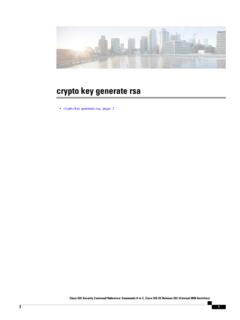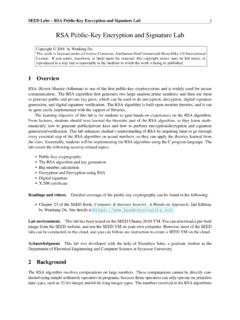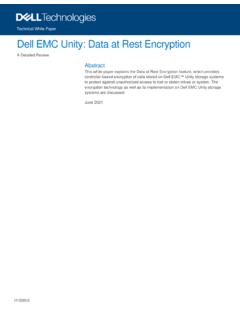Transcription of Public-Key Cryptography RSA Attacks against RSA
1 Public -Key CryptographyRSAA ttacks against RSASyst me et S curit 1 Public Key Cryptography Overview Proposed in Diffie and Hellman (1976) New Directions in Cryptography Public-Key encryption schemes public key distribution systems Diffie-Hellman key agreement protocol digital signature Public-Key encryption was proposed in 1970 by James Ellis in a classified paper made public in 1997 by the British Governmental Communications Headquarters Diffie-Hellman key agreement and concept of digital signature are still due to Diffie & Hellman2 Public Key Encryption Public-Key encryption each party has a PAIR (K, K-1) of keys.
2 K is the public key and K-1is the private key, such thatDK-1[EK[M ]] = M Knowing the Public-Key and the cipher, it is computationally infeasibleto compute the private key Public-Key crypto systems are thus known to be asymmetriccrypto systems The Public-Key K may be made publicly available, , in a publicly available directory Manycan encrypt, only one can decrypt34 Public -Key CryptographyPublic -Key EncryptionNeedsOne -way Trapdoor Functions Given a Public-Key crypto system, Alice has public key K EKmust be a one-way function, : knowing y=EK [x], it should be difficultto find x However, EKmust notbe one-way from Alice s perspective.
3 The function EKmust have a trapdoorsuch that the knowledge of the trapdoor enables Alice to invert it5 Trapdoor One-way Functions Definition: A funcEon f: {0,1}* {0,1}* is a trapdoor one-way function iff f(x) is a one-way function; however, given some extra informationit becomes feasible to compute f-1: given y, find x y = f(x)6 RSA Algorithm Invented in 1978 by Ron Rivest, AdiShamir and Leonard Adleman Published as R. L. Rivest, A. Shamir, L. Adleman, "On Digital Signatures and Public Key Cryptosystems", Communications of the ACM, vol.
4 21 no 2, pp. 120-126, Feb 1978 Security relies on the difficulty of factoring large composite numbers Essentially the same algorithm was discovered in 1973 by Clifford Cocks, who works for the British intelligence7 Zpq* Let p and q be two large primes Denote their product n=pq. Zn*= Zpq* contains, by definition, all integers in the range [1,pq-1] that are relatively prime to both p and q The size of Zn* is (pq ) = (p -1)(q -1)=n -(p+q)+1 For every x Zpq*, x(p-1)(q-1) 1 modn8 Exponentiation in Zpq* Motivation: We want to use exponentiation for encryption Let e be an integer, 1<e<(p-1)(q -1) When is the function f(x)=xea one-to-onefunction in Zpq*?
5 If xeis one-to-one, then it is a permutationin Zpq*9 Exponentiation in Zpq* Claim: If e is relatively primeto (p -1)(q -1) then f(x)= xeis a one-to-one function in Zpq* Proofby constructing the inverse function of f() As gcd {e,(p -1)(q -1)}=1, then there exists d and k ed=1+k(p-1)(q -1) Let y= xe, then yd=(xe)d=x1+k(p-1)(q-1)=x (mod pq), , g(y)= ydis the inverse of f(x)= Public Key crypto System Key generation: Select 2 large prime numbers of about the same size, p and q Compute n = pq, and (n) = (p-1)(q-1) Select a random integer e, 1 < e < (n), gcd(e, (n)) = 1 Compute d, 1< d < (n) ed 1 mod (n)(using the Extended Euclidean Algorithm) Public key: (e, n) Private key: d Note: p and q must remain secret11 RSA Description (cont.)
6 Encryption Given a message M, 0 < M < n M Zn- {0} use public key (e, n) compute C = Memod n C Zn- {0} Decryption Given a ciphertext C, use private key (d) Compute Cdmod n = (Memod n)dmod n == Medmod n = M12 RSA Example (1) p = 17, q = 11, n = 187, (n) = 160 Let us choose e=7, since gcd (7,160)=1 Let us compute d: de=1 mod 160 , d=23 (in fact, 23x7=161 = 1 mod 160 Public key = {7,187} Secret key = 2313 RSA Example (1) cont. Given message (plaintext) M= 88 (note that 88<187) Encryption: C = 887mod 187 = 11 Decryption: M = 1123mod 187 = 8814 RSA Example (2) p = 11, q = 7, n = 77, (n) = 60 e = 37, d = 13 (ed = 481; ed mod 60 = 1) Let M = 15.)
7 Then C Memod nC 1537(mod 77) = 71 M Cdmod nM 7113(mod 77) = 1515 Why does RSA work? Need to show that (Me)d(mod n) = M, n = pq Since ed 1 (mod (n))We have that ed = t (n) + 1, for some integer t. So:(Me)d(mod n)= Mt (n) + 1 (mod n)=(M (n))t M1 (mod n)=1tM (mod n) = M (mod n)as Implementation n, p, q The security of RSA depends on how large n is, which is often measured in the number of bits for n. Current recommendation is 1024 bits for n. p and q should have the same bit length, so for 1024 bits RSA, p and q should be about 512 bits.
8 But p-qshould notbe small!17 RSA Implementation Select p and q prime numbers In practice, select random numbers, then test for primality Many implementations use the Rabin-Miller test, (probabilistic test) 18 RSA Implementation e e is usually chosen to be 3 or 216+ 1 = 65537 Binary: 11 or 10000000000000001 In order to speed up the encryption the smaller the numberof 1 bits, the better why?19 Square -and -Multiply Algorithm forModular Exponentiation Modular exponentation means Computing xcmod n In RSA, both encryption and decryption are modular exponentations.
9 Obviously, the computation of xcmod n can be done using c-1 modular multiplication, but this is very inefficient if c is large. Note that in RSA, c can be as big as (n) 1. The well-known square-and-multiply approach reduces the number of modular multiplications required to compute xcmod n to at most 2k, where k is the number of bits in the binary representation of -and -Multiply Algorithm forModular Exponentiation Square-and-multiply assumes that the exponent c is represented in binary notation, say : = 2 Algorithm: Square-and-multiply (x, n, c = c1c0)z=1for i = k-1 downto 0 {z = z2mod nif ci= 1 then z = (z * x) mod n}return z21 Square -and -Multiply Algorithm forModular Exponentiation.
10 Example Let us compute 97263533 mod 11413 x=9726, n=11413, c=3533 = 110111001101 (binary form)iciz11112X9726=972610197262X9726=26 599026592=56348156342X9726=91677191672X9 726=49586149582X9726=77835077832=6298406 2982=46293146292X9726=1018521101852X9726 =105101052=1102501110252X9726=5761 Probabilistic PrimalityTesting In setting up the RSA Cryptosystem, it is necessary to generatelarge randomprimes . In practice this is done by generating large randomnumbersand then test themfor primality using a probabilisticpolynomial-time Montecarlo algorithmlike Solovay-Strassenor Miller-Rabin algorithm.













